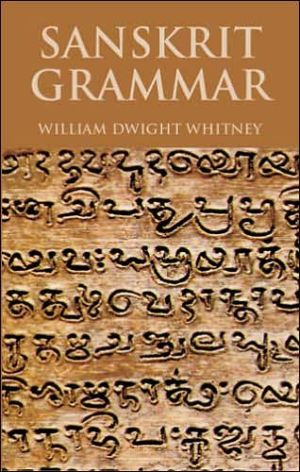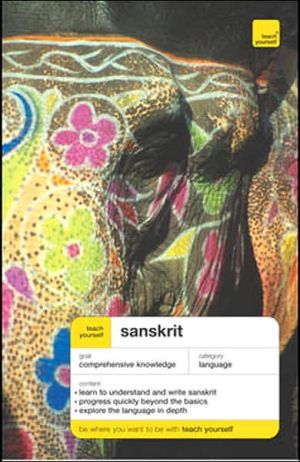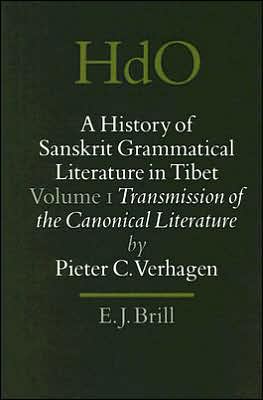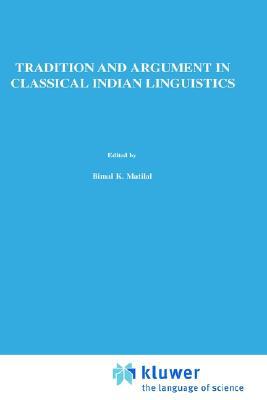A Sanskrit Grammar
As Latin is key to the study of Western classics, so Sanskrit is the language of ancient Indian literature. This guide begins with an introduction to the Sanskrit alphabet, followed by a treatment of the accent — its changes in combination, inflection, and tone. Succeeding chapters discuss declension, conjugation, parts of speech, more.
Search in google:
This Dover edition is an unabridged reprint of the third edition of A Sanskrit Grammar, Including both the Classical Language, and the older Dialects, of Veda and Brahmana, originally published by Ginn and Company, Boston, 1896. Whitney's (1827-1894) text remains one of the few Sanskrit grammars currently available, and will increase the accessibility of ancient Indian literature to students of Indian culture and history. Annotation ©2004 Book News, Inc., Portland, OR
PrefaceiiiIntroductionixI.Alphabet1II.System of Sounds; Pronunciation10Vowels10Consonants13Quantity27Accent28III.Rules of Euphonic Combination34Introductory34Principles37Rules of Vowel Combination42Permitted Finals49Deaspiration53Surd and Sonant Assimilation54Combinations of Final s and r56Conversion of s to s61Conversion of n to n54Conversion of Dental Mutes to Linguals and Palatals66Combinations of Final n69Combinations of Final m71The Palatal Mutes and Sibilant, and h72The Lingual Sibilant77Extension and Abbreviation78Strengthening and Weakening Processes81Guna and Vrddhi81Vowel-lengthening84Vowel-lightening85Nasal Increment86Reduplication87IV.Declension88Gender, Number, Case88Uses of the Cases89Endings of Declension103Variation of Stem107Accent in Declension108V.Nouns and Adjectives111Classification etc.111Declension I.Stems in a112Declension II.Stems in i and u116Declension III.Stems in Long Vowels (a, i, u): A. Root-words etc.124Stems in Diphthongs130B. Derivative Stems etc.131Declension IV.Stems in r or ar137Declension V.Stems in Consonants141A.Root-stems etc.143B.Derivative Stems in as is, us153C.Derivative Stems in an156D.In in161E.In ant or at163F.Perfect Participles in vans169G.Comparatives in yans or yas172Comparison173VI.Numerals177Cardinals177Ordinals etc.183VII.Pronouns185Personal185Demonstrative188Interrogative194Relative195Other Pronouns: Emphatic, Indefinite196Nouns used pronominally197Pronominal Derivatives, Possessives etc.197Adjectives declined pronominally199VIII.Conjugation200Voice, Tense, Mode, Number, Person200Verbal Adjectives and Nouns203Secondary Conjugations203Personal Endings204Subjunctive Mode209Optative211Imperative213Uses of the Modes215Participles220Augment220Reduplication222Accent of the Verb223IX.The Present-System227General227Conjugations and Conjugation Classes228Root-Class (second or ad-class)231Reduplicating Class (third or hu-class)242Nasal Class (seventh or rudh-class)250nu and u-Classes (fifth and eighth, or su- and tan-classes)254na-Class (ninth or kri-class)260a-Class (first or bhu-class)264Accented a-Class (sixth or tud-class)269ya-Class (fourth or div-class)271Accented ya-Class or Passive Conjugation275So-called tenth or cur-class277Uses of the Present and Imperfect278X.The Perfect-System279Perfect Tense279Perfect Participle291Modes of the Perfect292Pluperfect295Uses of the Perfect295XI.The Aorist-Systems297Classification297I.Simple Aorist1.Root-Aorist299Passive Aorist 3d sing3042.The a-Aorist305II.3.Reduplicated Aorist308III.Sibilant Aorist3134.The s-Aorist3145.The is-Aorist3206.The sis-Aorist3237.The sa-Aorist325Precative326Uses of the Aorist328XII.The Future-Systems330I.The s-Future331Preterit of the s-Future, Conditional334II.The Periphrastic Future335Uses of the Futures and Conditional337XIII.Verbal adjectives and Nouns: Participles, Infinitives, Gerunds340Passive Participle in ta or na340Past Active Participle in tavant344Future Passive Participles, Gerundives345Infinitives347Uses of the Infinitives351Gerunds355Adverbial Gerund in am359XIV.Derivative or Secondary Conjugation360I.Passive361II.Intensive362Present-System365Perfect, Aorist, Future, etc.370III.Desiderative372Present-System374Perfect, Aorist, Future, etc.376IV.Causative378Present-System380Perfect, Aorist, Future, etc.383V.Denominative386XV.Periphrastic and Compound Conjugation391The Periphrastic Perfect392Participial Periphrastic Phrases394Composition with Prepositional Prefixes395Other Verbal Compounds400XVI.Indeclinables403Adverbs403Prepositions414Conjunctions416Interjections417XVII.Derivation of Declinable Stems418A.Primary Derivatives420B.Secondary Derivatives454XVIII.Formation of Compound Stems480Classification480I.Copulative Compounds485II.Determinative Compounds489A.Dependent Compounds489B.Descriptive Compounds494III.Secondary Adjective Compounds501A.Possessive Compounds501B.Compounds with Governed Final Member511Adjective Compounds as Nouns and as Adverbs512Anomalous Compounds514Stem-finals altered in Composition514Loose Construction with Compounds515Appendix516A.Examples of Various Sanskrit Type516B.Example of Accentuated Text518Synopsis of the conjugation of roots bhu and kr520Sanskrit-Index521General-Index540




